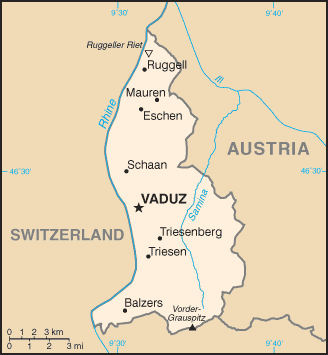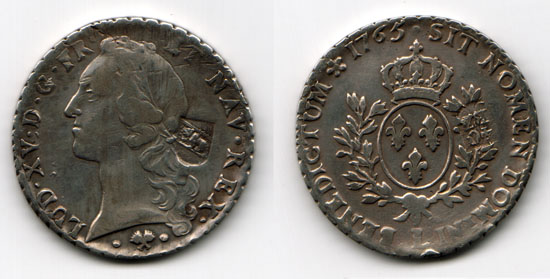|
Liechtenstein Inland Canal
The inland canal in Liechtenstein is a long artificial stream of water created between 1931 and 1943. The canal receives water from twelve Alpine streams and flows into the Alpine Rhine near the country's northern end. It is considered one of the most significant constructions in the country. History Plans to build an inland canal in Liechtenstein date back to the 18th-century due to increased waterlogging of the river and the restricted flow of streams in the Alpine valley. In 1834 a canal was built between Schaan and Bendern in order to address this, but there was no permanent drainage into the connecting Rhine river. In 1894, the proposal for a inland canal extensively flowing through the country was first brought up for discussion in the Landtag of Liechtenstein. After six years of reports, the plan was first adopted by engineer Josef Vogt based on the design of Austrian engineer Philipp Krapf, but was not conducted due to huge costs. Under the initiative of First Hoop ca ... [...More Info...] [...Related Items...] OR: [Wikipedia] [Google] [Baidu] |
Liechtenstein Asv2022-10 Img07 Vaduz Binnenkanal
Liechtenstein (), officially the Principality of Liechtenstein (german: link=no, Fürstentum Liechtenstein), is a German language, German-speaking microstate located in the Alps between Austria and Switzerland. Liechtenstein is a semi-constitutional monarchy headed by the prince of Liechtenstein. Liechtenstein is bordered by Switzerland to the west and south and Austria to the east and north. It is List of European countries by area, Europe's fourth-smallest country, with an area of just over and a population of 38,749 (). Divided into Municipalities of Liechtenstein, 11 municipalities, its capital is Vaduz, and its largest municipality is Schaan. It is also the smallest country to border two countries. Liechtenstein is a Landlocked country#Doubly landlocked, doubly landlocked country between Switzerland and Austria. Economically, Liechtenstein has one of the List of countries by GDP (PPP) per capita, highest gross domestic products per person in the world when adjusted for ... [...More Info...] [...Related Items...] OR: [Wikipedia] [Google] [Baidu] |
Dieter Nohlen
Dieter Nohlen (born 6 November 1939) is a German academic and political scientist. He currently holds the position of Emeritus Professor of Political Science in the Faculty of Economic and Social Sciences of the University of Heidelberg. An expert on electoral systems and political development, he has published several books. IDEA Bibliography Books published by Nohlen include: *''Electoral systems of the world'' (in German, 1978) *''Lexicon of politics'' (seven volumes) *''Elections and Electoral Systems'' (1996) *''Elections in Africa: A Data Handbook'' (1999 with Michael Krennerich and Bernhard Thibaut) *''Elections in Asia and the Pacific: A Data Handbook'' (2001 with and Christof Hartmann) ** ''Volume 2: South East Asia, East Asia, and the Pacific'' (2002), *''Vo ...[...More Info...] [...Related Items...] OR: [Wikipedia] [Google] [Baidu] |
Economy Of Liechtenstein
The economy of Liechtenstein is based on industry, with a small but significant agricultural sector, and services (especially general services, including tourism and information technology). The country participates in a customs union with Switzerland and uses the Swiss franc as its national currency. It imports more than 85% of its energy requirements. Liechtenstein has been a member of the European Free Trade Association (EFTA) since 1991 (previously its interests had been represented by Switzerland). It also has been a member of the European Economic Area (EEA) since May 1995 and participates in the Schengen Agreement for passport-free intra-European travel. History Liechtenstein's historical customs union with Austria was dissolved in 1919. A customs treaty was signed in 1923 and since its entering into force in 1924, Liechtenstein and Switzerland have been in a customs union with each other and as such the borders between the two countries are open. The German village ... [...More Info...] [...Related Items...] OR: [Wikipedia] [Google] [Baidu] |
Macro-engineering
In engineering, macro-engineering (alternatively known as macroengineering or macro engineering and as mega engineering) is the implementation of extremely large-scale design projects. It can be seen as a branch of civil engineering or structural engineering but just on a very large land area. In particular, macro-engineering is the process of marshaling and managing of resources, technology and public opinion on a large scale to carry out complex tasks that last over a long period. In contrast to conventional engineering projects, macro-engineering projects (called macro-projects or mega-projects) are multidisciplinary, involving collaboration from all fields of study; they involve not only engineers, but scientists, lawyers, industrialists, soldiers and politicians as well. Macro-projects are usually international; they override political boundaries because most countries lack the social, financial or physical ability to undertake them alone. As a consequence, macro-projects have ... [...More Info...] [...Related Items...] OR: [Wikipedia] [Google] [Baidu] |
Cuts (earthmoving)
Cut may refer to: Common uses * The act of cutting, the separation of an object into two through acutely-directed force ** A type of wound ** Cut (archaeology), a hole dug in the past ** Cut (clothing), the style or shape of a garment ** Cut (earthmoving), an excavation to make way for a transport route ** Cut (etiquette), a snub or slight such as failure to greet an acquaintance ** Cut (gems) ** Cut of meat ** Cutting agent, a diluent used to dilute illicit drugs Geography * Cut, Alba, Romania * Cut, Texas, an unincorporated community in Houston County, Texas * Cut, a village in Dumbrava Roșie, Neamț County, Romania * Cut River (Mackinac County, Michigan) * Cut River (Roscommon County, Michigan) * Cutral Có Airport, Argentina (IATA code CUT) * Cuts, Oise, France Computing and mathematics * Cut (logic programming) * cut (Unix), a command line utility * Cut, copy, and paste, a set of editing procedures * Control Unit Terminal, a kind of IBM display terminal for mainf ... [...More Info...] [...Related Items...] OR: [Wikipedia] [Google] [Baidu] |
Canals Opened In 1943
Canals or artificial waterways are waterways or engineered channels built for drainage management (e.g. flood control and irrigation) or for conveyancing water transport vehicles (e.g. water taxi). They carry free, calm surface flow under atmospheric pressure, and can be thought of as artificial rivers. In most cases, a canal has a series of dams and locks that create reservoirs of low speed current flow. These reservoirs are referred to as ''slack water levels'', often just called ''levels''. A canal can be called a ''navigation canal'' when it parallels a natural river and shares part of the latter's discharges and drainage basin, and leverages its resources by building dams and locks to increase and lengthen its stretches of slack water levels while staying in its valley. A canal can cut across a drainage divide atop a ridge, generally requiring an external water source above the highest elevation. The best-known example of such a canal is the Panama Canal. Many ... [...More Info...] [...Related Items...] OR: [Wikipedia] [Google] [Baidu] |
Geography Of Liechtenstein
The principality of Liechtenstein encompasses most of the eastern half of the Rhine Valley, wedged between Austria and Switzerland. The majority of the country's population is found in the western half along the Rhine River. Along with Uzbekistan, Liechtenstein is one of only two doubly landlocked countries in the world. Statistics Geographic coordinates: Area: 160 km2 (land, 0 km2 water) Land boundaries :''total:'' 76 km :''border countries:'' Austria 35 km, Switzerland 41 km Lake :The only lake in Liechtenstein is the Gampriner Seele. Land use :''arable land:'' 21.88% :''permanent crops:'' 0% :''other:'' 78.12% (2011) Terrain :Mostly mountainous (Alps) with Rhine Valley in western third Natural resources: :Hydroelectric potential, arable land Extreme points: * North - river Rhine, Ruggell * South - summit of Mazorakopf/Falknishorn (2,452 m), Triesen * East - border post 28, above Nenzinger Himmel * West - river Rhine, Balzers * highest - V ... [...More Info...] [...Related Items...] OR: [Wikipedia] [Google] [Baidu] |
Swiss Franc
The Swiss franc is the currency and legal tender of Switzerland and Liechtenstein. It is also legal tender in the Italian exclave of Campione d'Italia which is surrounded by Swiss territory. The Swiss National Bank (SNB) issues banknotes and the federal mint Swissmint issues coins. In its polyglot environment, it is often simply referred as german: Franken, french: franc, it, franco and rm, franc. It is also designated through signes: ''Fr'' Some fonts render the currency sign character "₣" (unicodebr>U+20A3 as ligatured Fr, following the German language convention for the Swiss Franc. However, most fonts render the character as F with a strikethrough on the lower left, which is the unofficial sign of French Franc. (in German language), ''fr.'' (in French, Italian, Romansh languages), as well as in any other language, or internationally as ''CHF'' which stands for ''.'' This acronym also serves as eponymous ISO 4217 code of the currency, CHF being used by banks and f ... [...More Info...] [...Related Items...] OR: [Wikipedia] [Google] [Baidu] |
Countess Georgina Von Wilczek
Countess Georgina von Wilczek (24 October 1921 – 18 October 1989) was Princess of Liechtenstein from 1943 to 1989 as the wife of Prince Franz Joseph II. She was the mother of Prince Hans-Adam II and was widely known as Gina. Biography Princess Georgina was born on 24 October 1921, in Graz, Austria. She was the daughter of Count Ferdinand von Wilczek (1893-1977) and Countess Norbertine "Nora" Kinsky von Wchinitz und Tettau (1888-1923). In 1923, when Georgina was just two years old, her mother died after giving birth to a stillborn child. Princess Gina received her formal education in the Sacre Coeur grammar school and a boarding school run by the Congregation of Jesus in Rome. She then studied languages at the University of Vienna and graduated as an interpreter in English, French and Italian. Georgina probably met her future husband, Prince Franz Joseph II, in early 1942. He was also her third cousin, and he had been the reigning Prince of Liechtenstein since 1938. They ... [...More Info...] [...Related Items...] OR: [Wikipedia] [Google] [Baidu] |
Franz Joseph II, Prince Of Liechtenstein
Franz Joseph II (Franz Josef Maria Aloys Alfred Karl Johannes Heinrich Michael Georg Ignaz Benediktus Gerhardus Majella; 16 August 1906 – 13 November 1989) was the reigning Prince of Liechtenstein from 25 July 1938 until his death. Franz Joseph was the son of Prince Aloys of Liechtenstein and Archduchess Elisabeth Amalie of Austria. He succeeded his childless grand-uncle, Prince Franz I, after his father renounced his right of succession in his favour in 1923. During his reign, women received voting rights for the first time, following a referendum on the topic (among men only) in 1984. Franz Joseph was an extremely popular sovereign in Liechtenstein. He was the first ruling prince to live full-time in the principality. He also oversaw the economic development of Liechtenstein from a poor agricultural backwater into one of the richest countries (per capita) in the world. World War II Liechtenstein remained neutral throughout World War II, and its neutrality was not viola ... [...More Info...] [...Related Items...] OR: [Wikipedia] [Google] [Baidu] |
Anton Frommelt
Anton Frommelt (14 March 1895 – 7 October 1975) was a pastor and political figure from Liechtenstein who served as the Deputy Prime Minister of Liechtenstein from 1933 to 1938. Early life Frommelt was born on 14 March 1895 in Schaan to the son carpenter Lorenz Frommelt and his mother Magdalena Vogt. He attended college in Stans and from 1920 he studied theology in Chur. He worked as an art teacher in the between 1920 and 1922. He was as a pastor in Triesen from 1922 until 1933. Career Frommelt was a member of the Landtag of Liechtenstein from 1928 and he served as the President of the Landtag of Liechtenstein from January 1928 to December 1944. Paul Vogt (1987). ''125 Jahre Landtag.'' Vaduz: Landtag of the Principality of Liechtenstein. In 1933 he was appointed by Prime Minister of Liechtenstein Josef Hoop to serve as the Deputy Prime Minister of Liechtenstein. In 1930 he had supported the approval for the building of a 23km long inland canal to increase the percent ... [...More Info...] [...Related Items...] OR: [Wikipedia] [Google] [Baidu] |



